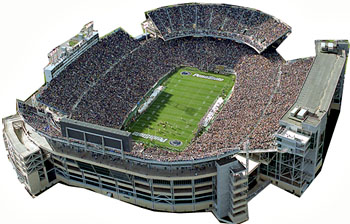Uniformitarianism and the Age of the Earth

Imagine that the 100 yards of Penn State's Beaver Stadium, or any other football field, are like a timeline of all of Earth's history, and you're the star of the team, driving for glory. The planet formed on your goal line, half of the Earth's history had passed as your team marched across the 50-yard line, and now the coach personally sent you, the acme of creation, to carry the ball across the opposition's goal line of today for the winning score. If you have been carrying the ball for the whole 20 years of your life, how far did you run? (If you're not 20 years old, pretend.)
Congratulations--tomorrow's newspaper will report that you gained just a shade under 0.0002 inch, or a bit less than 1/200 of the thickness of a sheet of paper. The defense was vanquished by your onslaught, and instant-replay officials weren't needed to see that you broke the plane of the goal.
Some people still insist that the Earth is no older, and looks no older, than the roughly 6000 years of written history. But, that is barely the thickness of a sheet of paper on the 100 yards of Earth's "dark backward and abysm of time," as Shakespeare called it. Geologists often feel sorry for those young-Earth supporters—they may have seen the instant-replay of the touchdown, but they missed the thrill of the game. So come along and see how the team got you the ball for those last two ten-thousandths of an inch!
What to do for Unit 10?
You will have one week to complete Unit 10. See the course calendar for specific due dates.
As you work your way through the online materials for Unit 10, you will encounter a video lecture, several vTrips, some animated diagrams (called GeoMations and GeoClips), additional reading assignments, a practice quiz, a "RockOn" quiz, and a "StudentsSpeak" Survey. The chart below provides an overview of the requirements for this unit.
| REQUIREMENTS | SUBMITTED FOR GRADING? |
|---|---|
| Read/view all of the Instructional Materials | No, but you will be tested on all of the material found in the Unit 10 Instructional Materials. |
| Submit Exercise #5: Puzzling Out Relative Time | Yes, this is the fifth of 6 Exercises and is worth 5% of your total grade. |
| Begin Exercise #6: Fossil Fuels (& Driving Hazards) | Yes, this is the last of 6 Exercises and is worth 5% of your total grade. |
| Take the Unit 10 "RockOn" quiz | Yes, this is the tenth of 12 end-of-unit RockOn quizzes and is worth 4.5% of your total grade. |
| Complete the "StudentsSpeak #11" survey | Yes, this is the eleventh of 12 weekly surveys and is worth 1% of your total grade. |
Questions?
If you have any questions, please feel free to email "All Teachers" and "All Teaching Assistants" through Canvas conversations.
Keep Reading!
On the following pages, you will find all of the information you need to successfully complete Unit 10, including the online textbook, a video lecture, several vTrips and animations, and an overview presentation.

Students who register for this Penn State course gain access to assignments and instructor feedback, and earn academic credit. Information about registering for this course is available from the Office of the University Registrar.